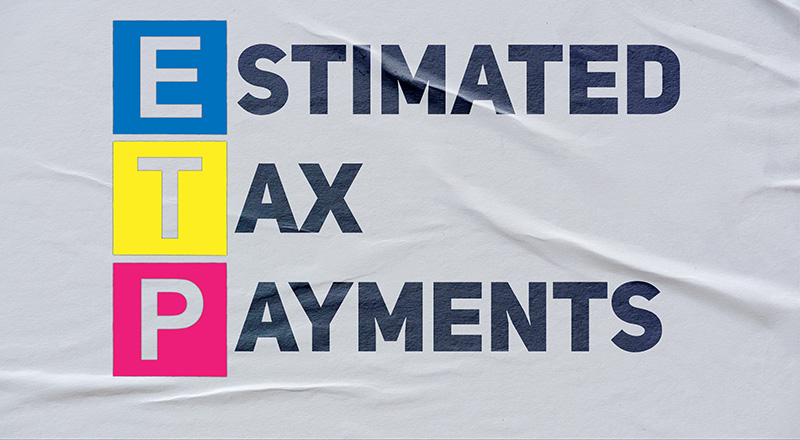What happens if you miss a quarterly estimated tax payment?
February, 27 2024 by Steve Banner, EA, MBA
Before we get started, let us briefly review the purpose of estimated tax payments for individual taxpayers. The underlying principle is that if you receive significant amounts of income during the year from which the proper amount of tax is not withheld, you should make regular payments throughout the year to offset the tax that you owe, instead of waiting until the end of the year to pay your taxes in a lump sum when you file your tax return. This is not a concern for many folks whose only income is from their paycheck as an employee, because taxes on that income are withheld by their employer and forwarded to the US Treasury on their behalf. However, employees should be aware that if they do not withhold enough from their wages, they may find themselves underwithheld and owing taxes when they file their return. If the taxpayer is underwithheld enough, they could incur an underpayment of estimated tax penalty. This is because we have a “pay-as-you-go” tax system.
But it’s a different story for taxpayers who are self-employed or receive income such as dividends, interest, capital gains, rents, and royalties. Tax on income received from these sources is usually not withheld by the payer. This means that those folks who receive these types of income are responsible for doing their own tax withholding. This is where the estimated tax payment system comes into the picture.
Under this system, you make a payment to the US Treasury four times each year, based on the estimated amount of tax you are likely to owe on your earnings that were not taxed before you received them. The IRS expects to receive these payments based on a regular, quarterly schedule that varies only slightly when the 15th of the month falls on a Saturday, Sunday, or holiday.
The schedules for the tax years 2023, 2024 and 2025 are set out in the tables below.
2023 Estimated Tax Payment Dates for Individuals
| Payment Number | Income Received During Period | Payment Due Date |
|---|---|---|
| 1 | January 1 to March 31, 2023 | April 18, 2023 |
| 2 | April 1 to May 31, 2023 | June 15, 2023 |
| 3 | June 1 to August 31, 2023 | September 15, 2023 |
| 4 | September 1 to December 31, 2023 | January 16, 2024 |
2024 Estimated Tax Payment Dates for Individuals
| Payment Number | Income Received During Period | Payment Due Date |
|---|---|---|
| 1 | January 1 to March 31, 2024 | April 15, 2024 |
| 2 | April 1 to May 31, 2024 | June 17, 2024 |
| 3 | June 1 to August 31, 2024 | September 16, 2024 |
| 4 | September 1 to December 31, 2024 | January 15, 2025 |
2025 Estimated Tax Payment Dates for Individuals
| Payment Number | Income Received During Period | Payment Due Date |
|---|---|---|
| 1 | January 1 to March 31, 2025 | April 15, 2025 |
| 2 | April 1 to May 31, 2025 | June 16, 2025 |
| 3 | June 1 to August 31, 2025 | September 15, 2025 |
| 4 | September 1 to December 31, 2025 | January 15, 2026 |
There are two good reasons for you to make each of these payments, and to do so according to the schedule. The first reason is that your payments allow you to avoid a potentially unpleasant cash flow surprise at the end of the year when you file your tax return and realize that you suddenly need to come up with, say, $10,000 to pay your tax bill. If you had made a series of smaller payments during the year, your year-end surprise would have been much less painful.
The second benefit you receive for making regular and timely payments is that you avoid the penalties and interest that the IRS charges if your payments are late or not made at all. Just for your information, as of the quarter commencing on October 1st, 2023, the rate of interest charged by the IRS on underpayments of estimated taxes was increased from 7% to 8%. The IRS reviews this rate each quarter, and the rate for the 1st quarter of 2024 remains at 8%.
But, if you happen to miss one of your quarterly estimated tax payments, all is not lost. As soon as you remember, you can go ahead and make the quarterly payment late. The payment can be made online or by mail. More information on how to make your estimated tax payment online can be found on the IRS Make a Payment webpage. If you mail your payment, be sure to include the quarterly voucher that the payment applies. The 2024 federal estimated tax vouchers can be found here. Another way you can make up a missed estimated tax payment is by increasing the withholding on your wages or retirement income. If you do incur an underpayment of estimated tax penalty, the IRS may waive or reduce the penalty under certain circumstances. These circumstances include:
- You or your spouse (if you file a joint return) retired in the past two years after reaching age 62 or became disabled and you underpaid your estimated taxes because of unusual circumstances, and not through willful neglect.
- You withheld or paid most of your taxes early in the year instead of spreading the payments out evenly throughout the year.
- Your income comes in at different times during the year and not evenly.
To request a waiver of the underpayment of the estimated tax penalty for the 2023 tax year, fill out and submit 2023 Form 2210, Underpayment of Estimated Tax by Individuals, Estates, and Trusts. The Instructions for Form 2210 for 2023 can be found here.
Also, the underpayment of the estimated tax penalty is generally not imposed under either of these conditions:
- You owe less than $1,000 with your tax return, or
- During the year, you paid at least the smaller of these two amounts:
- 90% of the tax shown on the current return, or
- 100% of the tax shown on the previous year’s return (110% for higher-income taxpayers).
In summary, our advice to you is to do your best not to miss any of your quarterly payments. However, if you do miss one or more payments and end up with a tax debt to the IRS, you could contact TaxAudit’s Tax Debt Relief experts and speak with an experienced tax professional for a cost-free, obligation-free discussion of your case.





